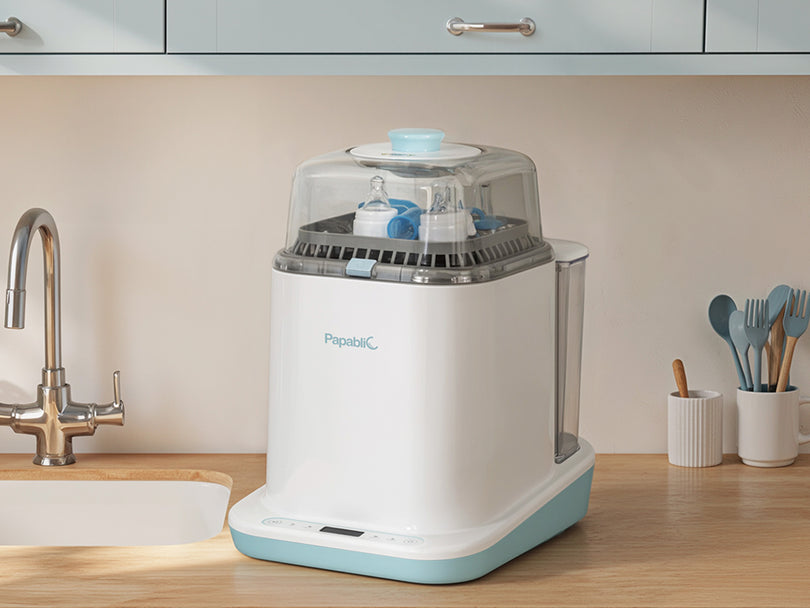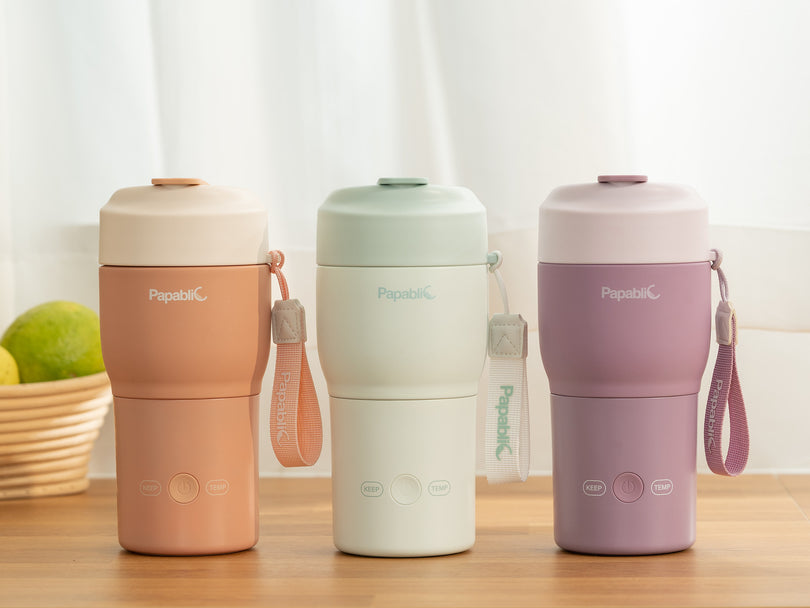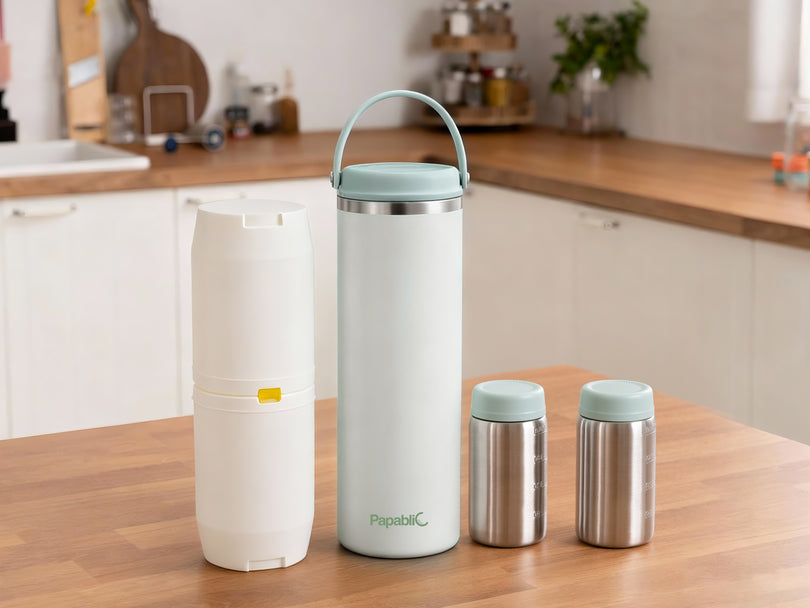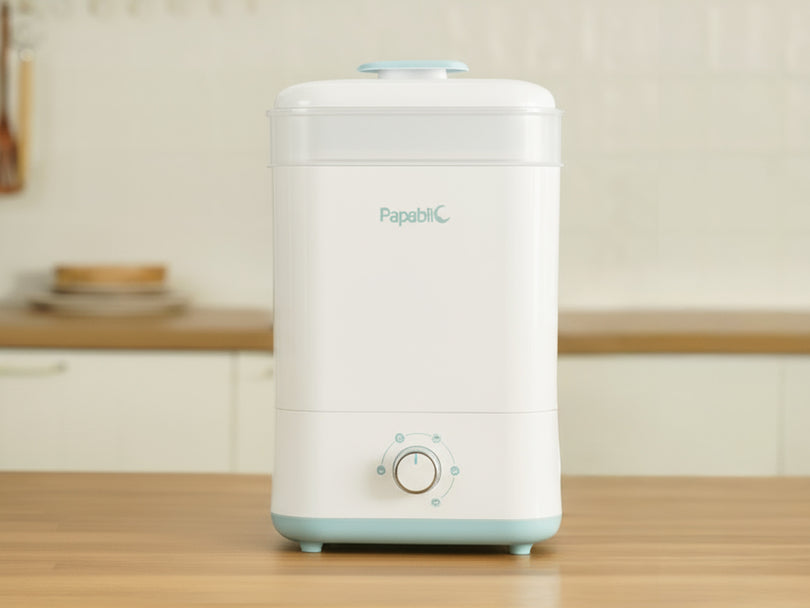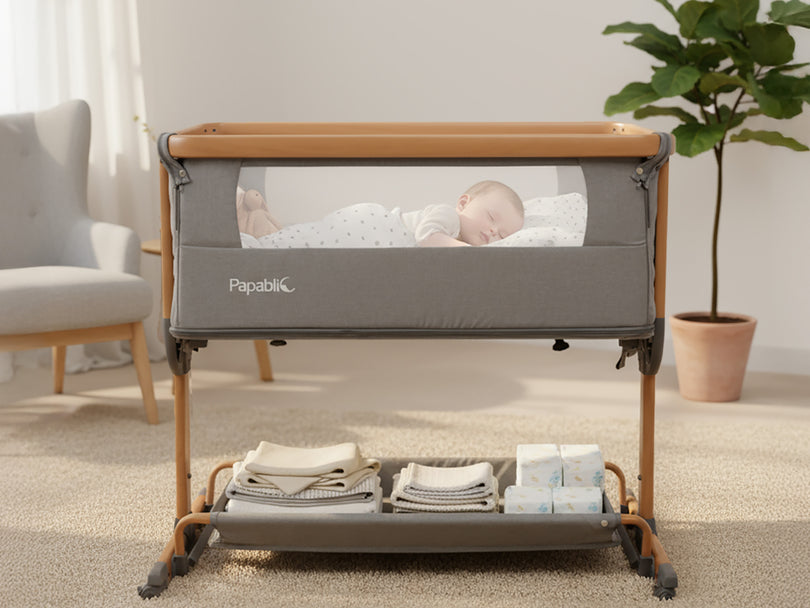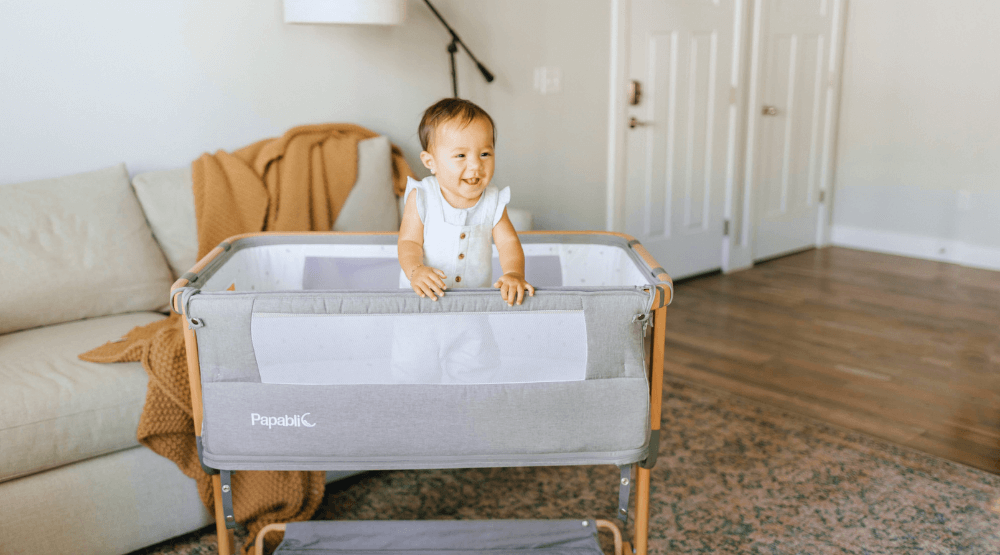
Selecting the right sleep space for your baby is a significant decision that involves careful consideration. The debate between a crib and a bassinet often leaves parents contemplating various factors.
In this article, we'll delve into the intricate details of bassinets and cribs, exploring their characteristics, benefits, disadvantages, and safety considerations. This information aims to empower you with the knowledge needed to make a well-informed decision for your little one's sleep environment.
Bassinet
What is a Bassinet?
A bassinet is a small bed specifically designed for infants.
It is characterized by its compact and portable structure, making it an ideal sleep solution for the early months of a baby's life. Bassinets typically have a basket-like design with a firm mattress and breathable sides. They are often lightweight and come with features such as handles or wheels for easy mobility. Bassinets are designed to be placed beside the parent's bed, providing convenient access during nighttime care routines.

Advantages of a Bassinet
- Proximity to Parents: One of the primary benefits of a bassinet is its ability to be placed beside the parent's bed. This close proximity allows for easy access to the baby during nighttime feedings, comforting, and monitoring.
- Convenient for Nighttime Care: The close proximity of a bassinet to the parent's bed simplifies nighttime care routines. Parents can attend to the baby's needs quickly without having to navigate through a larger space.
- Easy Portability: Bassinets are lightweight and often designed for portability. This feature enables parents to move the bassinet easily from room to room, keeping the baby close throughout the day.
- Space-Efficient: With their smaller size, bassinets are suitable for families with limited living space. They provide a snug sleeping space for newborns without taking up as much room as a crib.
- Secure Sleeping Environment: Bassinets typically have breathable mesh sides, ensuring proper air circulation around the baby. The firm mattress provides a safe and supportive sleep surface.
- Ideal for Initial Months: Bassinets are well-suited for the first few months of a baby's life when they require a smaller, cozier sleep space. The confined environment can provide a sense of security for the newborn.
- Adjustable Height: Many bassinets come with adjustable height settings. This feature allows parents to align the bassinet with the height of their bed, facilitating easy interaction without excessive bending or reaching.
- Transitional Sleep Solution: Bassinets serve as a transitional sleep solution before babies move on to larger cribs or beds. This flexibility makes them a practical choice for the evolving needs of a growing infant.
- Convenient for Daytime Naps: The portable nature of bassinets makes them convenient for daytime naps in various areas of the house. Parents can keep a watchful eye on the baby while accomplishing other tasks.
- Cozy and Nurturing: The design of bassinets often includes soft and comfortable bedding, creating a cozy and nurturing sleep environment for the baby.
Disadvantages of a Bassinet
Limited Use: While bassinets are ideal for the first few months, they may become impractical as the baby outgrows the snug confines and requires more space.
Weight Limit: Bassinets often have weight limits, necessitating a transition to a larger sleep space as the baby grows and gains weight.
Less Storage: Compared to cribs, bassinets may offer less storage space for baby essentials.
Not Convertible: Bassinets typically do not convert into larger beds, so parents may need to invest in a separate sleep solution as the baby transitions.
Less Stability: Due to their lightweight and portable nature, some bassinets may be less stable than cribs, especially when placed on uneven surfaces.
Potentially Shorter Lifespan: Bassinets have a shorter lifespan compared to cribs, making them a temporary solution for the early months.
Is Bassinet Safe?
Yes! bassinets are generally safe when used according to manufacturer guidelines and safe sleep recommendations. Here are key points to consider to ensure the safety of bassinets:
- Adhere to Manufacturer Guidelines:Follow the assembly instructions provided by the manufacturer. This includes properly securing all components, ensuring a stable base, and using the bassinet as intended.
- Weight Limit:Abide by the weight limit specified by the manufacturer. Once your baby exceeds this limit, it's time to transition to a larger sleep space to maintain stability.
- Firm Mattress:Use a firm mattress in the bassinet. A firm sleeping surface reduces the risk of Sudden Infant Death Syndrome (SIDS) and provides proper support for the baby's developing spine.
- Breathable Sides:Choose a bassinet with breathable mesh sides. Mesh promotes air circulation, reducing the risk of overheating and ensuring the baby has a clear view.
- Safe Sleep Position:Place the baby on their back to sleep in the bassinet. This sleep position is recommended by health professionals to reduce the risk of SIDS.
- No Additional Bedding:Avoid using soft bedding, such as pillows, blankets, or stuffed animals, inside the bassinet. These items can pose a suffocation risk to the baby.
- Safe Location:Position the bassinet in a safe location, away from hazards such as curtains, blinds, or cords to prevent entanglement.
Recommend Papablic Bassinet
It has four functions: portable bassinet, co-sleeper, cradle, and playard.
Beautiful appearance, sturdy and durable, and can be adjusted to the height you want.
It is the best choice for parents to care for their babies’ sleep.
Crib
What is a Crib?
A crib, also known as a cot or baby bed, is a specialized bed designed for infants and young children. It provides a safe and enclosed space for babies to sleep and rest. Cribs typically have high sides with vertical bars or slats and are designed to prevent the baby from climbing out. The bars or slats allow for proper air circulation and visibility. Cribs come in various styles and materials, including wood and metal.

Advantages of a Crib
- Stability and Safety:Cribs are designed with a sturdy and durable construction, providing a stable sleep environment for the baby. They are subject to stringent safety standards to ensure the well-being of the child.
- Convertible Options:Many cribs come with convertible features, allowing them to transform into toddler beds, daybeds, or even full-sized beds. This provides a long-term sleep solution, accommodating the child's growth.
- Ample Space:Cribs offer generous space for the baby to move around comfortably. The larger size accommodates growing infants and toddlers, providing a spacious sleep environment.
- Long-Term Use:Due to their larger size and convertible options, cribs can be part of a child's sleeping arrangement for an extended period. This long-term use makes them a cost-effective investment.
- Safety Standards:Cribs must meet safety standards, including appropriate spacing of bars, adjustable mattress height, and the absence of drop sides. This ensures that the crib provides a safe sleep space for the baby.
- Storage Options:Some cribs come with built-in storage solutions, such as drawers or shelves. This provides convenient space for storing baby essentials, reducing the need for additional furniture in the nursery.
- Customization:Cribs are available in various styles, colors, and materials, allowing parents to choose one that matches their nursery decor and personal preferences. This customization adds a decorative element to the nursery.
- Firm Mattress Support:Cribs are designed to accommodate firm mattresses, providing proper support for the baby's developing spine. This is crucial for reducing the risk of Sudden Infant Death Syndrome (SIDS).
- Safety Rails:Many cribs come with safety rails to prevent the baby from accidentally rolling out of bed. This feature adds an extra layer of protection.
- Establishes Routine:Having a designated sleep space in a crib can help establish a bedtime routine for the baby, contributing to better sleep patterns and consistency.
- Enclosed Sleep Environment:Cribs with high sides and bars create an enclosed sleep environment, reducing the likelihood of the baby getting tangled in bedding or rolling into unsafe positions during sleep.
Disadvantages of a Crib
Bulky Size:Cribs are typically larger and bulkier than other sleep solutions, taking up more space in the nursery. This can be a consideration for families with limited living space.
Limited Portability:Unlike smaller and more portable options like bassinets, cribs are not easily movable. Once set up, they are meant to stay in a fixed location, which can be inconvenient for families who want the baby to nap in different rooms.
Initial Cost:Quality cribs can be relatively expensive compared to other sleep solutions. While they offer long-term use and convertibility, the upfront cost may be a consideration for budget-conscious parents.
Assembly Required:Cribs often require assembly, and the process can be time-consuming. Improper assembly can compromise the stability and safety of the crib, emphasizing the importance of following manufacturer instructions carefully.
Transition Period:As a child transitions from a crib to a bed, there might be a period of adjustment. Some children may find the transition challenging, and parents may need to manage this adjustment phase.
Fixed Location:Cribs are stationary, and once set up, they remain in a fixed location in the nursery. This lack of mobility can be a disadvantage for parents who want the flexibility to move the baby's sleep space to different areas of the house.
Limited Use for Newborns:Cribs may be too large for newborns, and parents may initially need additional sleep solutions like bassinets for the first few months.
Safety Concerns (if not meeting standards):If a crib does not meet safety standards, it can pose risks to the baby. Issues such as inappropriate spacing of bars, unreliable fastenings, or lack of proper mattress support can compromise safety.
Is Crib Safe?
Yes, cribs are generally considered safe when used according to manufacturer guidelines and in adherence to established safety standards. However, ensuring crib safety involves following specific practices to create a secure sleep environment for the baby. Here are key points to consider:
Assembly and Maintenance:Follow the manufacturer's assembly instructions carefully to ensure the crib is properly set up. Regularly inspect the crib for any loose or damaged parts, and address any issues promptly.
Safety Standards:Choose a crib that meets safety standards and regulations. This includes appropriate spacing of bars or slats, proper mattress support, and the absence of drop sides. Compliance with safety standards ensures the crib provides a secure sleep space.
Firm Mattress:Use a firm mattress that fits snugly into the crib. A firm sleeping surface reduces the risk of Sudden Infant Death Syndrome (SIDS) and provides proper support for the baby's developing spine.
Proper Bedding:Avoid using soft bedding, such as pillows, blankets, or stuffed animals, inside the crib. These items can pose a suffocation risk. Use fitted sheets specifically designed for cribs.
Safe Sleep Position:Always place the baby on their back to sleep. This sleep position is recommended by health professionals to reduce the risk of SIDS.
Weight Limit:Adhere to the manufacturer's weight limit guidelines. Once the baby exceeds this limit, it's time to transition to a larger sleep space to maintain stability.
Avoid Hazardous Items:Keep the crib free of toys, loose bedding, and other potentially hazardous items. These items can pose risks to the baby's safety during sleep.
Secure Fastenings:Ensure that all fastenings, including screws, bolts, and nuts, are securely tightened. Loose fastenings can compromise the stability of the crib.
Safe Placement:Position the crib away from windows, curtains, blinds, and cords to prevent entanglement or strangulation hazards.
Supervision:Always supervise the baby when they are in the crib, especially during naptime or bedtime. Supervision ensures a quick response to any signs of distress.
In the intricate deliberation between a crib and a bassinet, the ideal choice hinges on your unique needs, living space, and personal preferences. A crib offers long-term stability and adaptability, while a bassinet provides the convenience of portability and proximity during the initial months. By carefully considering the features, benefits, disadvantages, and safety aspects of each option, you can create a safe, comfortable, and nurturing sleep space for your little one. Both cribs and bassinets play pivotal roles in your baby's sleep journey, catering to different stages of their early years. Take the time to assess your lifestyle and needs, and you'll find the perfect sleep solution for your precious bundle of joy.

